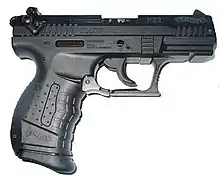| Walther P22 | |
|---|---|
 | |
| Type | Semi-automatic pistol |
| Place of origin | |
| Production history | |
| Manufacturer | Carl Walther GmbH |
| Produced | 2002–present |
| Specifications | |
| Length | 159 mm |
| Barrel length | 87 mm |
| Width | 29 mm |
| Height | 114 mm |
| Cartridge | .22 Long Rifle |
| Caliber | 5.59 mm |
| Action | Blowback |
| Muzzle velocity | 290 m/s |
| Effective firing range | 30-50 meters |
| Feed system | 10-round detachable box magazine |
| Sights | Adjustable open sights |
The Walther P22 is a semi-automatic pistol chambered for .22 Long Rifle (5.59 mm Caliber) rimfire ammunition. Manufactured by Carl Walther GmbH Sportwaffen, it was introduced in 2002 and has become very popular among shooting sports. It is distributed by the American gun company Walther America, associated with Smith & Wesson.
Operation

The P22 may be fired double action at about 11 pounds-force (49 N), and operates as a single action with slightly more than 4 pounds-force (18 N).[1] The P22 operates by blowback energy from the motion of the cartridge case as it is pushed to the rear by expanding gas created by the ignition of the propellant charge.[2] The action will not open until the projectile has left the barrel and the pressures have dropped to safe levels. The gun will not cycle efficiently unless high velocity .22 (5.59 mm) rounds are used.
Users
Criminal use
The Walther P22 was one of two semi-automatic weapons used in the 2007 Virginia Tech shooting,[3] with the other being a Glock 19. The P22 was also the selected weapon used in the 2008 Kauhajoki school shooting.[4]
See also
References
- ↑ "Walther P22". Guns & Ammo. 2008. Archived from the original on 15 April 2003.
- ↑ Chinn 1955, p. 3
- ↑ Williams, Reed; Morrison, Shawna (26 April 2007). "Police: No motive found". The Roanoke Times. Archived from the original on 7 February 2012.
- ↑ "Keskustelupalstoilla arvaillaan jo Kauhajoen ampujaa" (in Finnish). Iltalehti.fi. 23 September 2008. Retrieved 16 January 2009.
Sources
- Chinn, George M. (1955). The Machine Gun, Volume IV: Design Analysis of Automatic Firing Mechanisms and Related Components. Washington, D.C.: Bureau of Ordnance, Department of the Navy.